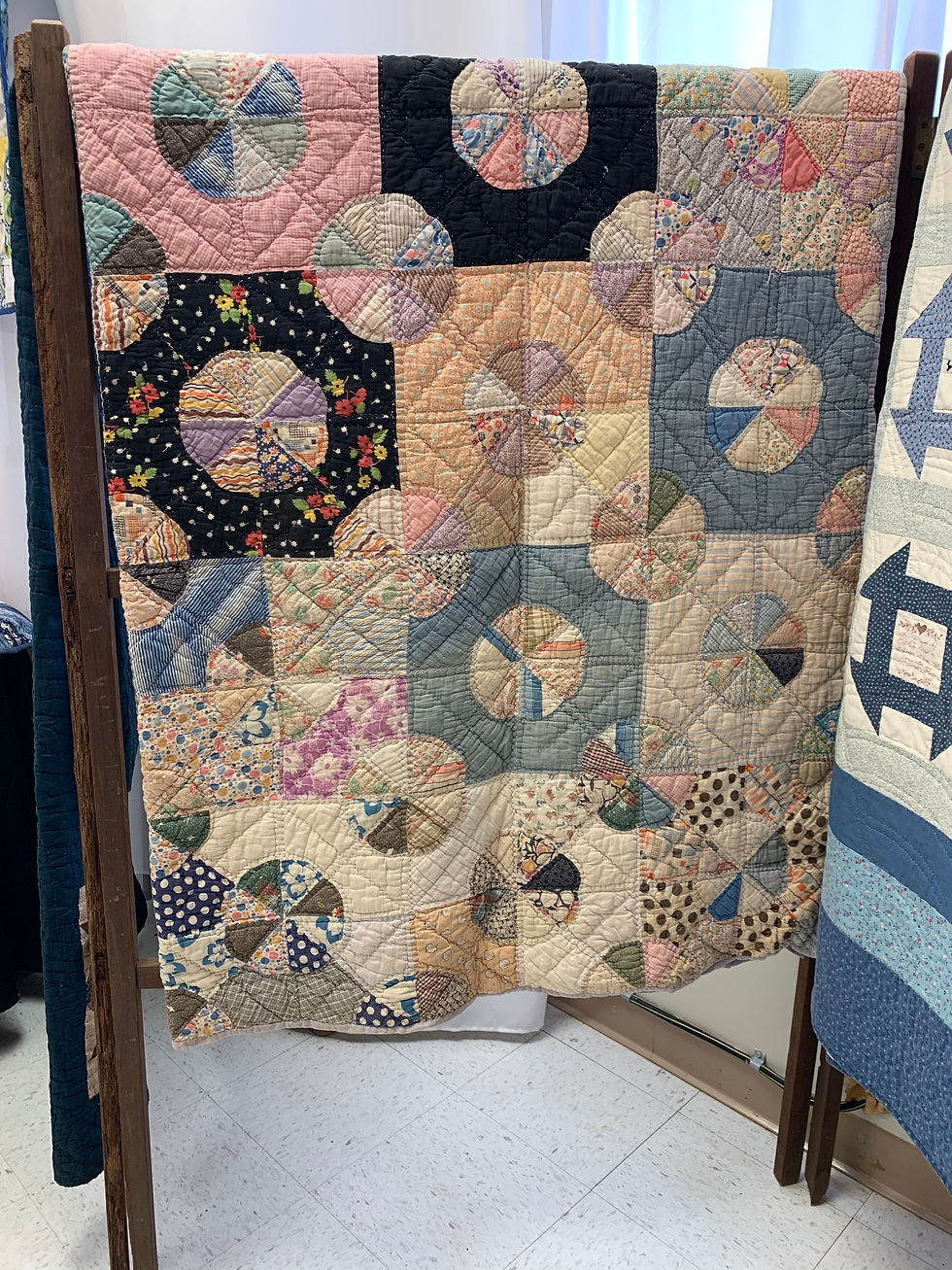Antique and Vintage Quilts
- Town of Pike Road

- Sep 21, 2020
- 3 min read
From the Collection of Bunny Rittenour Smith

Over the years I've collected several quilts. I bought what I liked, usually because I was attracted by the color and the fabrics. Sometimes the design caught my attention. If a quilt was made of blue fabrics, it had a much larger chance of coming home with me. Buy what you love. And buy quilts in the best condition that you can afford. Most have been used and loved and will have some signs of wear. Museum quality pieces can cost thousands! I want quilts that can be displayed, maybe lightly used, and enjoyed.

My mother-in-law gave me an old quilt that was in her family. It's a utility quilt, made in a curved design, a variation of "Robbing Peter to Pay Paul" or "Hearts and Gizzards." It is a scrap quilt with pops of black, a snugly quilt with a cotton bat and enough hand quilting to keep the batting from shifting when it's washed. Judging by its fabrics it was probably made in the 1930s or 40s.
When a quilt is being appraised, unless it comes with a written history or has been mentioned in dated letters or a will, the fabrics used will give the best clues to its age. There are books with examples of fabrics, block designs, and certain colors that are associated with general times frames that can help in determining its age. If a quilt is repaired, it is dated by the newest fabrics in it. That is why valuable vintage quilts are repaired with vintage and antique fabrics if at all possible. Sometimes the old dyes used to color fabrics will damage the fibers and disintegrate them over the years. To stabilize a quilt and keep it from coming apart, the affected areas can be covered with silk crepeline which is very sheer, almost transparent, if similar vintage fabrics cannot be found.

There are several other utility quilts that I purchased because of the Cadet and Indigo blue fabrics in them. Those fabrics indicate 1880-1910 time period. Shirtings, fabrics with white or off-white backgrounds and small colored motifs, were also popular during this time. In a Beaufort, South Carolina antique shop I spotted a quilt made of beige and browns with wide solid indigo sashing. The blocks are Goose Tracks or Cross & Crown. It's probably my oldest, between 1860-1880.
The blue embroidered Days of the Week Sunbonnet Sue Girls isn't technically a quilt because it isn't made of 3 layers-a top, a middle layer (usually batting) and a backing. It may have been a summer coverlet for a child's bed. These types of patterns were mostly seen from the 1880's to 1925. Later blocks were made from iron on transfers which you may still find today. I found it at a yard sale in Arkansas. It was probably made in the 1940's.

One quilt of a very simple design is just bright, multicolored prints, cut in squares and alternated with a white cotton or bleached muslin. It is probably a 1930s-1940s, Depression Era quilt as these colors and prints were popular. It is not made of feed sacks which were often used for aprons, children's clothing, and quilts during that era. A line of fabrics named Aunt Grace 1930's Reproduction made by Judie Rothermel for Marcus came out 2003. Since then she has added other reproductions fabrics to her line and other designers have put out their own lines of reproduction fabrics. We hope you enjoyed our quilt show and now have a better appreciation for some of the quilts that you or your relatives might have. Someone probably put a lot of time and effort into making them. We hope you now see quilts in a different “light”.




Дякую за думку — підхід справді перегукується з рішеннями у сфері aaadesign.
Є блог https://infosaray.com.ua, що вразив мене своєю атмосферою. У ньому публікують цікаві статті для допитливих. Вони доступні й зрозумілі, а фото створюють гарний візуальний ефект.
Сьогодні хочу поділитися блогом https://lifehata.com.ua, який справді вартий перегляду. Там є багато пізнавальних матеріалів. Читати їх легко, а картинки роблять читання приємнішим.
The adidas gazelle mens outfit is a classic look, pairing perfectly with iconic adidas gazelle campus sneakers for a stylish, casual vibe. For women,campus women adidas offers the popular adidas shoes women campus,with designs like campus adidas shoes womens delivering both comfort and flair.Adidas campus shoes are a great choice for those seeking versatile footwear, and the campus adidas shoes collection includes the iconic adidas campus 00s and adidas women's campus 00s shoes,inspired by vintage style. Whether you're interested in grade school sambas, adidas samba campus,or the timeless women's campus adidas,these sneakers bring a retro charm.adidas online shopping usa offers a variety of options, including womens adidas campus shoes and campus adidas originals that cater to every style preference. Campus 00s shoes women and adidas shoes campus provide the perfect mix…
Click Here